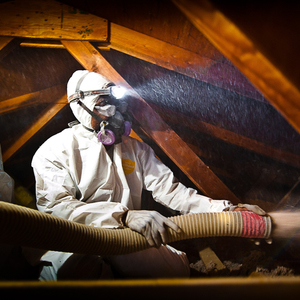
Do building scientists sometimes wake up and feel like Bill Murray in “Groundhog Day,” trapped in a time loop where no matter how many times they try to explain the importance of air-sealing nobody listens? It must have seemed that way at times, but builders and building codes are gradually heeding their advice and houses are slowly but surely getting tighter—and the result is lower heating and cooling bills, healthier indoor air, and more durable structures.
A certain level of air tightness is now required by the International Residential Code. In Climate Zones 1 and 2, the air leakage rate in new houses should not exceed five air changes per hour at a pressure difference of 50 pascals (ach50) when measured with a blower door; in Climate Zones 3 through 8, the limit is 3 ach50. Conscientious builders will be the first to say these limits are not a big deal. But it gets harder when the goal is certification under a more stringent program. The German Passive House standard, for example, requires an air leakage rate of no more than 0.6 ach50, and builders and owner/builders who try to hit this metric can spend a lot of time finding and plugging even tiny air leaks in the building enclosure.
What is a reasonable goal? A 2013 study by the Lawrence Berkeley National Laboratory concluded that the 5 ach50 and 3 ach50 guidelines are a good middle ground that would save U.S. consumers about $33 billion a year in energy bills. Lower leakage rates will, of course, save more money but are more difficult to achieve.
As more builders get serious about reducing air leaks, manufacturers have responded with a greater variety of products. Some of them are more expensive and finicky than others, but if a builder wants to produce a house that’s close to airtight, he…
Weekly Newsletter
Get building science and energy efficiency advice, plus special offers, in your inbox.

This article is only available to GBA Prime Members
Sign up for a free trial and get instant access to this article as well as GBA’s complete library of premium articles and construction details.
Start Free TrialAlready a member? Log in















9 Comments
The fully-adhered membrane is windproof and rainproof, according to the manufacturer, but it’s also diffusion-open so any moisture inside the wall can dry to the exterior as well as the interior. Another option is Henry’s Blueskin.
Just to avoid misinterpretation--Henry's Blueskin VP100 and VP160 are their vapor-permeable self-adhered products. Henry's vapor impermeable products are often called "Blueskin" in the field, and they shouldn't be confused with each other. The link is correct, though (points to VP100).
Most of the major manufacturers seem to offer a vapor-permeable self-adhered membrane: Grace enV-s, 3M 3015 VP, Dörken DELTA®-VENT SA, VaproShield, and many others.
If it costs $4.6K to air seal a new build to passive house standards, that would likely pay back immediately in savings on mechanicals purchased.
Not really, because it turns out they don't make equipment small enough for PH homes. PH HVAC designers say you actually have to spend more to get a good system for a low energy home. It's nuts. We need better products.
Another downside to Tremco Acoustical sealant is that it smells awful and the smell persists for months. Its ingredient list includes residual oil--the bottom of the barrel leftovers after a refining process. That means it's an unknown mix of hydrocarbons, some of which are almost surely harmful to the installers or the residents of the well sealed house. It's hard to know exactly how bad that mix of unknown sludge is for health but I don't think anyone using it should call themsleves a green builder.
Contega HF is a great substitute: works for the same applications, is more pleasant to be around, and reading the safety data sheet is raised no red flags for me. The solvent used is ethanol.
Tremco makes another non-skinning acoustic sealant without the smell (geared towards commercial) called TremPro JS773 - it's off-white and less expensive than the black goo version. Can be readily found online and at commercial supply houses.
I do not consider Contega HF a like-to-like Tremco replacement - it skins over, shrinks, loses a lot of elasticity compared to Tremco's non-skinning acoustic sealants. Adhesion is very good. It's also considerably more expensive.
From my tests, Green Glue Compound works far better as like-to-like Tremco replacement than Contega HF- it doesn't skin or harden and retains high elasticity and good adhesion. (Note, don't confuse with Green Glue Sealant that acts - and looks - like Contega HF). Green Glue Compound is also about half the cost as Contega HF.
I'd be very dubious about using any other brand of so-called acoustic sealant - my tests showed most readily-available big box store 'acoustic sealants' were effectively worthless (OSI/Titebond/3M etc). They look like cheap acrylic latex caulks - cure very dense, lose almost all flexibility and have poor-to-terrible adhesion once cured - all undesirable qualities for air-sealing purposes.
do you mind posting a link to the green glue you recommend? thanks
Contega HF stays flexible and pliable like the Tremco?
I loved Siga's tape, flat out best, I will use it for my windows sealing project. But Siga’s Majvest 500 SA is on the pricey side if you compare to Delta's Vent-SA (1.47 ft2 vs 0.62 ft2) in my neck of wood.
Does anyone use duct mastic for air sealing homes? What are the advantages or disadvantages of using duct mastic, instead of expensive tapes or liquid-applied air sealing products?
Log in or become a member to post a comment.
Sign up Log in